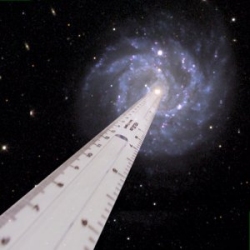Measuring Distances

Credit: The Schools' Observatory
Knowing the distance to objects in space is important. It is also very hard - you can't just use a ruler!
Astronomers over hundreds of years have worked out new ways to measure the distance to stars and galaxies.
The ways we measure distance fall into 2 types:
- Direct methods: These are ones which measure the distance to the object directly. There is no need to compare it to anything else. An example is measuring the distance to the Moon. We can shine a laser from the Earth towards the Moon where it is reflected back to Earth. It is reflected back off special mirrors left by the astronauts who went to the Moon. The time it takes the light to travel to the Moon and back is then measured to give a distance.
- Relative methods: With these methods, you can only measure relative distances. For example, you might be able to say that Star A is 4 times further away than Star B. But you can't say how far that is in kilometres or light-years.
Of course, if you can measure the distance to Star A using a direct method, you can then work out a direct distance to Star B. This is called calibration.
Sometimes a relative method has to be calibrated by another relative method, which is calibrated by a direct one. When there are several stages or "steps" like this. For this reason it is sometimes called the Distance Ladder.
The table below shows examples of methods used by astronomers to work out the distance to objects in space.
| Method | Kind of object | Typical Distances | Direct or Relative |
| Radar | The Moon and nearby planets like Mars. | Millions to 100s of millions of km | Direct |
| Parallax | Nearby stars (Find out more) |
Up to a few 100 light-years | Direct |
| "Standard Candle" stars | Many stars and some nearby galaxies (Find out more) |
Depending on the kind of star, these can be used to find distances of many millions of light-years | Relative |
| Redshift | Distant galaxies (Find out more) |
Right to the most distant galaxies, 1000s of millions of light-years away | Relative |

